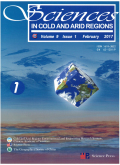- 钛学术文献服务平台 \
- 学术期刊 \
- 基础科学期刊 \
- 天文学、地球科学期刊 \
- 寒旱区科学(英文版)期刊 \
60-year changes and mechanisms of Urumqi Glacier No. 1 in the eastern Tianshan of China, Central Asia
60-year changes and mechanisms of Urumqi Glacier No. 1 in the eastern Tianshan of China, Central Asia
基本信息来源于合作网站,原文需代理用户跳转至来源网站获取
摘要:
Worldwide examination of glacier change is based on detailed observations from only a small number of glaciers. The ground-based detailed individual glacier monitoring is of strong need and extremely important in both regional and global scales. A long-term integrated multi-level monitoring has been carried out on Urumqi Glacier No. 1 (UG1) at the headwa-ters of the Urumqi River in the eastern Tianshan Mountains of Central Asia since 1959 by the Tianshan Glaciological Sta-tion, Chinese Acamedey of Sciences (CAS), and the glaciological datasets promise to be the best in China. The boundaries of all glacier zones moved up, resulting in a shrunk accumulation area. The stratigraphy features of the snowpack on the glacier were found to be significantly altered by climate warming. Mass balances of UG1 show accelerated mass loss since 1960, which were attributed to three mechanisms. The glacier has been contracting at an accelerated rate since 1962, resulting in a total reduction of 0.37 km2 or 19.3%from 1962 to 2018. Glacier runoff measured at the UG1 hydrometeoro-logical station demonstrates a significant increase from 1959 to 2018 with a large interannual fluctuation, which is inverse-ly correlated with the glacier's mass balance. This study analyzes on the changes in glacier zones, mass balance, area and length, and streamflow in the nival glacial catchment over the past 60 years. It provides critical insight into the processes and mechanisms of glacier recession in response to climate change. The results are not only representative of those gla-ciers in the Tianshan mountains, but also for the continental-type throughout the world. The direct observation data form an essential basis for evaluating mountain glacier changes and the impact of glacier shrinkage on water resources in the in-terior drainage rivers within the vast arid and semi-arid land in northwestern China as well as Central Asia.

推荐文章
Major Miocene geological events in southern Tibet and eastern Asia induced by the subduction of the
Ridge subduction
Eastern Tibetan Plateau
Cenozoic mineralization
Seismic anomaly
Geochemistry, mineralogy, and radioactivity of the Abu Furad Area, Central Eastern Desert, Egypt
Hydrothermal alterations
Major oxide and trace elements
Radiometry
Mineralogy
Geochemistry
Altered syenogranites
Egypt
Behavior of rare earth elements in granitic profiles, eastern Tibetan Plateau, China
Chemical weathering
Eu anomaly
Critical zone
Soil weathering
内容分析
关键词云
关键词热度
相关文献总数
(/次)
(/年)
文献信息
| 篇名 | 60-year changes and mechanisms of Urumqi Glacier No. 1 in the eastern Tianshan of China, Central Asia | ||
| 来源期刊 | 寒旱区科学(英文版) | 学科 | |
| 关键词 | |||
| 年,卷(期) | 2020,(6) | 所属期刊栏目 | Articles |
| 研究方向 | 页码范围 | 380-388 | |
| 页数 | 9页 | 分类号 | |
| 字数 | 语种 | 英文 | |
| DOI | |||
五维指标
引文网络
引文网络
二级参考文献 (21)
共引文献 (11)
参考文献 (10)
节点文献
引证文献 (0)
同被引文献 (0)
二级引证文献 (0)
1984(1)
- 参考文献(0)
- 二级参考文献(1)
1986(2)
- 参考文献(0)
- 二级参考文献(2)
1988(1)
- 参考文献(0)
- 二级参考文献(1)
1992(1)
- 参考文献(0)
- 二级参考文献(1)
1994(1)
- 参考文献(0)
- 二级参考文献(1)
1998(1)
- 参考文献(0)
- 二级参考文献(1)
1999(1)
- 参考文献(0)
- 二级参考文献(1)
2000(1)
- 参考文献(0)
- 二级参考文献(1)
2001(1)
- 参考文献(0)
- 二级参考文献(1)
2006(1)
- 参考文献(0)
- 二级参考文献(1)
2007(2)
- 参考文献(0)
- 二级参考文献(2)
2008(1)
- 参考文献(0)
- 二级参考文献(1)
2009(1)
- 参考文献(1)
- 二级参考文献(0)
2010(4)
- 参考文献(1)
- 二级参考文献(3)
2011(3)
- 参考文献(2)
- 二级参考文献(1)
2012(3)
- 参考文献(1)
- 二级参考文献(2)
2015(2)
- 参考文献(1)
- 二级参考文献(1)
2016(1)
- 参考文献(1)
- 二级参考文献(0)
2018(2)
- 参考文献(2)
- 二级参考文献(0)
2019(1)
- 参考文献(1)
- 二级参考文献(0)
2020(0)
- 参考文献(0)
- 二级参考文献(0)
- 引证文献(0)
- 二级引证文献(0)
引文网络交叉学科
相关学者/机构
期刊影响力
寒旱区科学(英文版)
主办单位:
中国科学院寒区旱区环境与工程研究所
科学出版社有限责任公司
出版周期:
双月刊
ISSN:
1674-3822
CN:
62-1201/P
开本:
出版地:
甘肃省兰州市东岗西路320号
邮发代号:
创刊时间:
语种:
eng
出版文献量(篇)
870
总下载数(次)
0
总被引数(次)
1072
期刊文献
相关文献
推荐文献
- 期刊分类
- 期刊(年)
- 期刊(期)
- 期刊推荐
力学
化学
地球物理学
地质学
基础科学综合
大学学报
天文学
天文学、地球科学
数学
气象学
海洋学
物理学
生物学
生物科学
自然地理学和测绘学
自然科学总论
自然科学理论与方法
资源科学
非线性科学与系统科学
寒旱区科学(英文版)2022
寒旱区科学(英文版)2021
寒旱区科学(英文版)2020
寒旱区科学(英文版)2019
寒旱区科学(英文版)2018
寒旱区科学(英文版)2017
寒旱区科学(英文版)2016
寒旱区科学(英文版)2015
寒旱区科学(英文版)2014
寒旱区科学(英文版)2013
寒旱区科学(英文版)2012
寒旱区科学(英文版)2011
寒旱区科学(英文版)2010
寒旱区科学(英文版)2009
寒旱区科学(英文版)2008
寒旱区科学(英文版)2020年第6期
寒旱区科学(英文版)2020年第5期
寒旱区科学(英文版)2020年第4期
寒旱区科学(英文版)2020年第3期
寒旱区科学(英文版)2020年第2期
寒旱区科学(英文版)2020年第1期

 免费查重
免费查重










